City of Greater Geelong
The City of Greater Geelong is a local government area in the Barwon South West region of Victoria, Australia, located in the western part of the state. It covers an area of 1,248 square kilometres (482 sq mi) and, had a population of 271,057 as of the 2021 Australian census.[3] It is primarily urban with the vast majority of its population living in the Greater Geelong urban area, while other significant settlements within the LGA include Anakie, Balliang, Barwon Heads, Batesford, Ceres, Clifton Springs, Drysdale, Lara, Ocean Grove, Portarlington and St Leonards. It was formed in 1993 from the amalgamation of the Rural City of Bellarine, Shire of Corio, City of Geelong, City of Geelong West, City of Newtown, City of South Barwon, and parts of Shire of Barrabool and Shire of Bannockburn.[1]
| City of Greater Geelong Victoria | |||||||||||||||
|---|---|---|---|---|---|---|---|---|---|---|---|---|---|---|---|
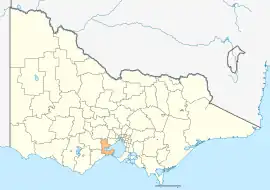 Location of the City of Greater Geelong in Victoria | |||||||||||||||
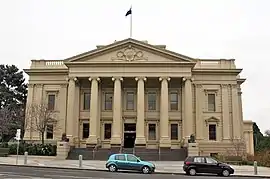 Geelong Town Hall, 2007 | |||||||||||||||
| Population | 271,057 (2021) (12th) | ||||||||||||||
| • Density | 217.19/km2 (562.53/sq mi) | ||||||||||||||
| Established | 1993 | ||||||||||||||
| Gazetted | 18 May 1993[1] | ||||||||||||||
| Area | 1,248 km2 (481.9 sq mi)[2] | ||||||||||||||
| Mayor | Trent Sullivan (Liberal) | ||||||||||||||
| Council seat | Geelong city centre | ||||||||||||||
| Region | Barwon South West | ||||||||||||||
| State electorate(s) | |||||||||||||||
| Federal division(s) | |||||||||||||||
| Website | City of Greater Geelong | ||||||||||||||
| |||||||||||||||
The City is governed and administered by the Greater Geelong City Council; its seat of local government and administrative centre is located at the council headquarters in Geelong, it also has service centres located in Drysdale, Ocean Grove and several other locations within Geelong. The City is named after the main urban settlement located in the centre-west of the LGA, that is Geelong, which is also the LGA's most populous urban centre with a population of 211,986.[4]
In 2019, City of Greater Geelong announced a new headquarters across the road from WorkSafe Victoria. The project will be part of the new "Civic Precinct" in the Geelong CBD.
History of former municipalities
- 1838 – Geelong (Aboriginal word for 'Ocean') region declared a town
- 1849 – Geelong incorporated as a Town
- 1853 – Barrabool road district proclaimed
- 1853 – Portarlington Road District proclaimed
- 1856 – Connewarre Road District proclaimed
- 1857 – South Barwon Municipal District proclaimed
- 1857 – South Barwon Road District proclaimed
- 1858 – Newtown and Chilwell borough proclaimed
- 1860 – Portarlington Road District renamed as Indented Head Road District
- 1861 – Corio Road District proclaimed
- 1862 – Bannockburn Road District proclaimed
- 1863 – Meredith Road District proclaimed
- 1863 – Queenscliff and Point Lonsdale separated from Indented Head Road District to form Queenscliffe Municipal District. Redesignated as Queenscliffe Borough October 1963.
- 1863 – South Barwon Borough created by amalgamating South Barwon Municipal District and South Barwon Road District
- 1864 – Bannockburn Road District redesignated as Shire
- 1864 – Corio Road District redesignated as Shire
- 1865 – Indented Head Road District redesignated and renamed as Bellarine Shire
- 1874 – South Barwon Shire created by amalgamating Connewarre Road District and South Barwon Borough
- 1875 – Geelong West Borough proclaimed
- 1910 – Geelong proclaimed a City
- 1915 – Meredith Shire added to Bannockburn Shire
- 1922 – Geelong West proclaimed a Town
- 1924 – Newtown and Chilwell proclaimed a Town
- 1929 – Geelong West proclaimed a City
- 1959 – Newtown and Chilwell proclaimed a City
- 1967 – Newtown and Chilwell City renamed as Newtown City
- 1974 – South Barwon proclaimed a City
- 1989 – Bellarine proclaimed a City
- 1993 – City of Greater Geelong formed by amalgamating part of Bannockburn Shire, part of Barrabool Shire, Bellarine Rural City, Corio Shire, Geelong City, Newtown City & South Barwon City. The part that had been in South Barwon City was then transferred to Surf Coast Shire on its creation in March 1994.
Sourced from Appendix V, A Journey to Destiny 1890–1990 – 100 Years of Cement Manufacturing at Fyansford by Australian Cement Limited .[5]
Council
Council (as of 2023)
Due to conflicts in the previous council a new electoral structure was established for Geelong in 2017. The number of wards was reduced to 4 with 3 councillors for each (except Windermere having 2) elected by proportional representation. Residents were also no longer able to directly elect a mayor. [6] The current councillors, in order of election at the 2020 election, are:[7]
| Ward | Party | Councillor | Notes | |
|---|---|---|---|---|
| Bellarine | Put Climate First | Elise Wilkinson | Elected on a countback to replace Stephanie Asher | |
| Independent Liberal | Trent Sullivan | Mayor | ||
| Independent Labor | Jim Mason | |||
| Brownbill | Independent Labor | Melissa Cadwell | Elected on a countback to replace Sarah Mansfield | |
| Independent | Eddy Kontelj | |||
| Independent | Peter Murrihy | |||
| Kardinia | Independent | Bruce Harwood | ||
| Independent Liberal | Ron Nelson | |||
| Put Climate First | Belinda Moloney | |||
| Windermere | Independent | Anthony Aitken | ||
| Socialist Alliance | Sarah Hathway | Elected on a countback to replace Kylie Grzybek[8] | ||
Election results
| Party | Votes | % | Swing | Seats | Change | ||
|---|---|---|---|---|---|---|---|
| Independent | 58,513 | 35.52 | 4 | ||||
| Independent Liberal | 43,263 | 26.46 | 4 | ||||
| Independent Labor | 25,648 | 15.57 | 1 | ||||
| Greens | 17,081 | 10.37 | 1 | ||||
| Put Climate First | 12,518 | 7.60 | +7.60 | 1 | |||
| Socialist Alliance | 4,292 | 2.61 | 0 | ||||
| Animal Justice | 3,408 | 2.07 | 0 | ||||
| Formal votes | 164,723 | ||||||
| Informal votes | 7,474 | ||||||
| Total | 172,197 | 100.00 | 11 | ||||
| Registered voters / turnout | 204,092 | 84.37 | |||||
| Party | Candidate | Votes | % | ±% | |
|---|---|---|---|---|---|
| Independent Liberal | Stephanie Asher | 17,149 | 35.66 | ||
| Independent Liberal | Trent Sullivan | 5,580 | 11.60 | ||
| Independent Labor | Jim Mason | 5,486 | 11.41 | ||
| Greens | Cory Wolverton | 4,388 | 9.12 | ||
| Independent | Tom O’Connor | 3,881 | 8.07 | ||
| Independent | Stephen Simmonds | 3,615 | 7.52 | ||
| Put Climate First | Elise Wilkinson | 3,397 | 7.06 | ||
| Independent | Tom Harrison | 3,051 | 6.34 | ||
| Animal Justice | Naomi Adams | 868 | 1.80 | ||
| Independent | Michael Fairweather | 674 | 1.40 | ||
| Total formal votes | 48,089 | 95.39 | |||
| Informal votes | 2,324 | 4.61 | |||
| Turnout | 50,413 | 85.24 | |||
| Independent Liberal hold | Swing | ||||
| Independent Liberal hold | Swing | ||||
| Independent Labor hold | Swing | ||||
| Party | Candidate | Votes | % | ±% | |
|---|---|---|---|---|---|
| Greens | Sarah Mansfield | 10,412 | 23.12 | ||
| Independent | Peter Murrihy | 6,914 | 15.35 | ||
| Independent Liberal | Eddy Kontelj | 6,809 | 15.12 | ||
| Independent Liberal | Stretch Kontelj | 6,593 | 14.64 | ||
| Independent Labor | Melissa Cadwell | 5,360 | 11.90 | ||
| Independent | Jose Rodriguez | 2,000 | 4.44 | ||
| Put Climate First | Sandi Dwyer | 1,917 | 4.26 | ||
| Independent | Gabriel Wenyika | 1,212 | 2.69 | ||
| Independent | Dean Hope | 1,167 | 2.59 | ||
| Independent | Bernie Franke | 1,021 | 2.27 | ||
| Independent Labor | Louis Hehir | 984 | 2.19 | ||
| Independent Labor | Alex Csar | 642 | 1.43 | ||
| Total formal votes | 45,031 | 95.12 | |||
| Informal votes | 2,309 | 4.88 | |||
| Turnout | 47,340 | 83.95 | |||
| Greens hold | Swing | ||||
| Independent hold | Swing | ||||
| Independent Liberal hold | Swing | ||||
| Party | Candidate | Votes | % | ±% | |
|---|---|---|---|---|---|
| Independent | Bruce Harwood | 8,781 | 19.76 | ||
| Independent Liberal | Ron Nelson | 7,132 | 16.05 | ||
| Independent Labor | Jack Williams | 4,113 | 9.25 | ||
| Put Climate First | Belinda Moloney | 4,069 | 9.15 | ||
| Independent Labor | Andrew Alexander | 4,063 | 9.14 | ||
| Independent | Pat Murnane | 3,856 | 8.68 | ||
| Independent Labor | Andy Richards | 2,916 | 6.56 | ||
| Animal Justice | Jen Gamble | 2,540 | 5.71 | ||
| Greens | Anthony Hamilton-Smith | 2,281 | 5.13 | ||
| Independent Labor | Atamjit Singh | 2,084 | 4.69 | ||
| Independent | Michael Stangel | 1,930 | 4.34 | ||
| Independent | Mark Brunger | 684 | 1.54 | ||
| Total formal votes | 44,449 | 95.68 | |||
| Informal votes | 2,008 | 4.32 | |||
| Turnout | 46,457 | 85.95 | |||
| Independent hold | Swing | ||||
| Independent Liberal hold | Swing | ||||
| Put Climate First gain | Swing | ||||
| Party | Candidate | Votes | % | ±% | |
|---|---|---|---|---|---|
| Independent | Anthony Aitken | 10,525 | 38.76 | ||
| Independent | Kylie Grzybek | 6,103 | 22.48 | ||
| Socialist Alliance | Sarah Hathway | 4,292 | 15.81 | ||
| Put Climate First | Monique Connell | 3,135 | 11.55 | ||
| Independent | Enamul Haque | 3,099 | 11.41 | ||
| Total formal votes | 27,154 | 97.02 | |||
| Informal votes | 833 | 2.98 | |||
| Turnout | 27,987 | 81.11 | |||
| Independent hold | Swing | ||||
| Independent hold | Swing | ||||
Administrators
In December 2015, the Minister for Local Government Natalie Hutchins appointed a Commission of Inquiry into the Greater Geelong City Council in response to concerns about the workplace culture and adequacy of governance structures.[9]
The Inquiry found that the council is riven with conflict, unable to manage Geelong's economic challenges, has dysfunctional leadership and has a culture of bullying.[10]
On the recommendation of the Commission, the Victorian Government dismissed the entire Greater Geelong City Council on 16 April 2016[11] and appointed Yehudi Blacher as interim administrator.[12] On 25 May 2016, Dr Kathy Alexander (chairperson), Peter Dorling and Laurinda Gardner were sworn in as administrators, replacing Yehudi Blacher.[13]
Under the Local Government (Greater Geelong City Council) Act 2016, the panel of administrators constitutes the Greater Geelong City Council, and has the same functions, powers and duties as the Greater Geelong City Council and its councillors. Likewise, the chairperson of the panel of administrators has the same functions, powers and duties as the mayor of the council.[14]
The council was run by administrators until fresh council elections were held on 27 October 2017.[15]

Former and current Mayors
- Gerry Smith (1995–1998)
- Ken Jarvis (1998–2000)
- Michael Crutchfield (2000–2001)
- Stretch Kontelj (2001–2002)
- Barbara Abley (2002–2004)
- Ed Coppe (2004)
- Shane Dowling (2004–2005)
- Peter McMullin (2005–2006)
- Bruce Harwood (2006–2008)
- John Mitchell (2008–2012)
- Keith Fagg (2012–2013)[16]
- Darryn Lyons (2013–2016)[17]
- Bruce Harwood (2017–2019)
- Stephanie Asher (2019–2022)
- Peter Murrihy (2022-present)
Former and current Deputy Mayors
- Tony Ansett (2003–2004)
- John Mitchell (2007–2008)
- Rod Macdonald (2008–2009)
- Bruce Harwood (2009–2010)
- Cameron Granger (2010–2012)
- Stretch Kontelj (2012–2013)
- Bruce Harwood (2013–2014)
- Michelle Heagney (2014–2016)
- Peter Murrihy (2017–2019)
- Kylie Grzybek (2019–2020)
- Trent Sullivan (2020-present)
Administration and governance
The council meets in the council chambers at the council headquarters in the Geelong City Hall Offices, which is also the location of the council's administrative activities. Council customer service centres are located in Belmont, Corio, Drysdale, Geelong West, Ocean Grove, Waurn Ponds and at Brougham St in Geelong.
Townships and localities
The 2021 census, the city had a population of 271,057 up from 233,429 in the 2016 census[18]
| Population | ||
|---|---|---|
| Locality | 2016 | 2021 |
| Anakie^ | 690 | 734 |
| Armstrong Creek | 4,247 | 11,247 |
| Avalon | 293 | 255 |
| Balliang^ | 290 | 254 |
| Barwon Heads | 3,875 | 4,353 |
| Batesford^ | 952 | 1,141 |
| Bell Park | 5,009 | 5,602 |
| Bell Post Hill | 4,919 | 5,083 |
| Bellarine | 169 | 169 |
| Belmont | 14,054 | 15,066 |
| Breakwater | 1,014 | 1,060 |
| Breamlea^ | 162 | 151 |
| Ceres | 254 | 266 |
| Charlemont | 364 | 2,612 |
| Clifton Springs | 7,519 | 7,646 |
| Population | ||
|---|---|---|
| Locality | 2016 | 2021 |
| Connewarre^ | 788 | 953 |
| Corio | 15,296 | 15,497 |
| Curlewis | 1,551 | 4,175 |
| Drumcondra | 560 | 571 |
| Drysdale | 4,275 | 4,976 |
| East Geelong | 3,862 | 4,012 |
| Fyansford | 196 | 1,206 |
| Geelong | 5,210 | 5,811 |
| Geelong West | 6,966 | 7,345 |
| Grovedale | 14,308 | 14,869 |
| Hamlyn Heights | 6,293 | 6,518 |
| Herne Hill | 3,413 | 3,507 |
| Highton | 18,953 | 20,736 |
| Indented Head | 1,133 | 1,391 |
| Lara | 16,355 | 19,014 |
| Population | ||
|---|---|---|
| Locality | 2016 | 2021 |
| Leopold | 12,814 | 13,272 |
| Little River^ | 1,322 | 1,353 |
| Lovely Banks | 2,301 | 2,782 |
| Manifold Heights | 2,649 | 2,681 |
| Mannerim | 88 | 108 |
| Marcus Hill | 159 | 164 |
| Marshall | 1,885 | 2,299 |
| Moolap | 1,373 | 1,825 |
| Moorabool | 90 | 94 |
| Mount Duneed^ | 1,578 | 6,182 |
| Newcomb | 4,500 | 4,704 |
| Newtown | 122 | 189 |
| Norlane | 8,306 | 8,682 |
| North Geelong | 2,966 | 3,225 |
| North Shore | 357 | 325 |
| Population | ||
|---|---|---|
| Locality | 2016 | 2021 |
| Ocean Grove | 14,165 | 17,714 |
| Point Lonsdale^ | 2,684 | 3,788 |
| Point Wilson | 0 | 0 |
| Portarlington | 3,619 | 4,436 |
| Rippleside | 875 | 994 |
| South Geelong | 993 | 1,014 |
| St Albans Park | 4,843 | 4,942 |
| St Leonards | 2,480 | 3,542 |
| Staughton Vale | 98 | 105 |
| Swan Bay | 59 | 103 |
| Thomson | 0 | 0 |
| Wallington | 1,364 | 1,515 |
| Wandana Heights | 2,037 | 2,195 |
| Waurn Ponds | 5,046 | 4,956 |
| Whittington | 3,879 | 3,990 |
^ - Territory divided with another LGA
Sister cities
Geelong has sister city relations with the following cities:[19]
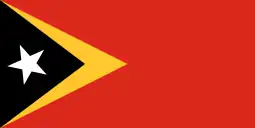 Viqueque, East Timor
Viqueque, East Timor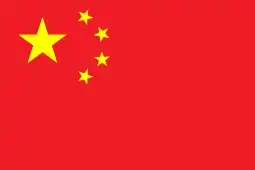 Lianyungang, China
Lianyungang, China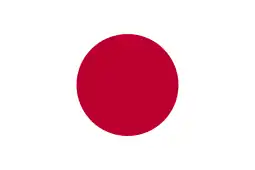 Izumiotsu, Japan
Izumiotsu, Japan
References
- Victoria Government Gazette – Online Archive (1837–1997). "Order estg the City of Greater Geelong: S27 of 1993". State Library of Victoria. State Government of Victoria (published 18 May 1993). pp. 1–3. Retrieved 10 January 2014.
- "3218.0 – Regional Population Growth, Australia, 2017–18: Population Estimates by Local Government Area (ASGS 2018), 2017 to 2018". Australian Bureau of Statistics. Australian Bureau of Statistics. 27 March 2019. Retrieved 25 October 2019. Estimated resident population, 30 June 2018.
- "2021 Greater Geelong, Census All persons QuickStats | Australian Bureau of Statistics". www.abs.gov.au. Retrieved 9 July 2022.
- "2021 Geelong, Census All persons QuickStats | Australian Bureau of Statistics". www.abs.gov.au. Retrieved 9 July 2022.
- John, McNeil (1990). A Journey to Destiny 1890–1990 – 100 Years of Cement Manufacturing at Fyansford by Australian Cement Limited. Australian Cement Limited.
- Victorian Electoral Commission (2017). "Greater Geelong City Council's Electoral Structure" (PDF). State of Victoria (Victorian Electoral Commission). Retrieved 19 November 2017.
- "Greater Geelong City Council election results 2020". www.vec.vic.gov.au. Retrieved 11 November 2020.
- Sue Bull (28 June 2023). "Socialist Sarah Hathway elected to the City of Greater Geelong Council". greenleft. Retrieved 19 October 2023.
- "Commission Of Inquiry Appointed To Geelong". Premier of Victoria. 1 December 2015. Retrieved 28 April 2016.
- "Report of the Commission of Inquiry into Greater Geelong City Council". State Government of Victoria. 12 April 2016. Archived from the original on 29 June 2016. Retrieved 28 April 2016.
- Local Government (Greater Geelong City Council) Act 2016 (Vic) s 2
- "Dismissal Of Greater Geelong City Council". Premier of Victoria. 12 April 2016. Retrieved 28 April 2016.
- "Administrators assume the role of Mayor and Councillors". City of Greater Geelong. Retrieved 29 May 2016.
- Local Government (Greater Geelong City Council) Act 2016 (Vic) s 7
- "Geelong Council officially sacked, elections to be held in 2017, as bill passes Parliament". ABC News. Australian Broadcasting Corporation. 14 April 2016. Retrieved 28 April 2016.
- Paul, Margaret (16 August 2013). "Geelong Mayor Keith Fagg quits because of health problems". ABC News. Australian Broadcasting Corporation. Retrieved 17 August 2013.
- Heritage, Stuart (26 November 2013). "Darryn Lyons: what reality TV has taught us about Geelong's new mayor". Guardian. Retrieved 6 December 2013.
- "Census | Australian Bureau of Statistics". www.abs.gov.au. 11 January 2023.
- "About Geelong". Intown Geelong. Archived from the original on 3 August 2009.